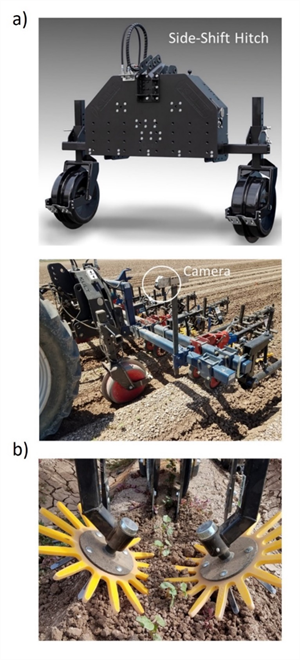
Frost and freeze damage affect countless fruit and vegetable growers leading to yield losses and occasionally the loss of the entire crop. Frost damage occurs when the temperature briefly dips below freezing (32°F).With a frost, the water within plant tissue may or may not actually freeze, depending on other conditions. A frost becomes a freeze event when ice forms within and between the cell walls of plant tissue. When this occurs, water expands and can burst cell walls. Symptoms of frost damage on vegetables include brown or blackening of plant tissues, dropping of leaves and flowers, translucent limp leaves, and cracking of the fruit. Symptoms are usually vegetable specific and vary depending on the hardiness of the crop and lowest temperature reached. A lot of times frost injury is followed by secondary infection by bacteria or opportunist fungi confusing with plant disease.
Most susceptible to frost and freezing injury: Asparagus, snap beans, Cucumbers, eggplant, lemons, lettuce, limes, okra, peppers, sweet potato
Moderately susceptible to frost and freezing injury: Broccoli, Carrots, Cauliflower, Celery, Grapefruit, Grapes, Oranges, Parsley, Radish, Spinach, Squash
Least susceptible to frost and freezing injury: Brussels sprouts, Cabbage, Dates, Kale, Kohlrabi, Parsnips, Turnips, Beets
More information:
In the preceding issue of UA Veg IPM Updates, the article below was published with an incorrect link to the video mentioned. For those interested in the video, which contains trial results and insightful videos of the technologies in action, the article has been updated with the correct link and is being reposted.
A couple years ago, we conducted evaluations of various “new” technologies for cultivating weeds in cotton as compared to conventional methods. The new technologies included 1) a camera-guided side-shift hitch and 2) finger weeders, an in-row weeding tool (Fig. 1). Camera-guidance of the maneuverable hitch allows cultivating tools to be positioned close to the seed row. In the study, the uncultivated band was 3.5" for the camera-guided system, and 6” for the conventional cultivator. The aim of evaluating these technologies was to determine their efficacy in controlling herbicide resistant weeds. Trials conducted over 3 years showed that use of camera-guidance improved weed control by more than 30% and finger weeders removed about 45% of the in-row weeds. Overall weed control using the two technologies together was roughly > 90% for broadleaf weeds and about 85% for all weeds species.
Studies conducted by Texas A&M over two years showed similar results (Dotray et. al, 2021).
It is logical to think that similar type results would be realized in vegetable crops such as broccoli and cauliflower, plants that also have fairly long plant stems at the seedling stage of growth. A better than 40% reduction of in-row weeds would significantly lower hand weeding requirements. If you are interested in trying these technologies in vegetable or other crops on your farm, please contact me. We still have the equipment and I’d be happy to work with you.
A presentation given on the trial results and videos of the equipment used operating can be found by clicking here or on image below.
References
Dotray, P.A., Keeling, J.W., & Russell, K.R. 2021. Precision cultivation with finger weeder systems. Project No. 20-190 Final Report. Cary, N.C: Cotton Inc.
Acknowledgements
Project partially funded and supported by Arizona Cotton Growers Association, Cotton Inc., KULT-Kress, LLC and Keithly-Williams Fabrication. We thank them for their support.

Fig. 1. Technologies for precision cultivation and in-row weeding
used in efficacy trials included a a) a camera-guided side-shift hitch
attached to a cultivator and b) in-row weeding tools (finger weeders).
Fig. 2. Click on image above to watch presentation on precision cultivation and in-row weeding technologies.
Postemergence herbicides used for grass control in vegetables include Poast (sethoxydim), Select (clethodim) and Fusilade (fluazifop) and the generics of these active ingredients. When some grasses have escape or have survived the application of Pefar, Kerb and Balan these selective grass herbicides can come to the rescue and have shown to be a great tool for weed management.
The above-mentioned herbicides are all Acetyl CoA carboxylase or ACCase inhibitors. These products work slowly and even slower at lower temperatures and shorter days. Treated grasses should stop growing immediately and will slowly turn yellow, red and gradually die as the crop grows. The process takes about 15-21days. Select (clethodim) works the faster than Poast (sethoxydim), and it isrecommended to add a crop oil concentrate for better activity with the exception of Select Max which can be used either with crop oil concentrate or non-ionic surfactant.
References:
Results of pheromone and sticky trap catches can be viewed here.
Corn earworm: CEW moth counts remain at low levels in all areas, well below average for this time of year.
Beet armyworm: Trap increased areawide; above average compared to previous years.
Cabbage looper: Cabbage looper counts decreased in all areas; below average for this time of season.
Diamondback moth: DBM moth counts decreased in most areas. About average for this time of the year.
Whitefly: Adult movement beginning at low levels, average for early spring.
Thrips: Thrips adult counts reached their peak for the season. Above average compared with previous years.
Aphids: Aphid movement decreased in all areas; below average for late-March.
Leafminers: Adults remain low in most locations, below average for March.